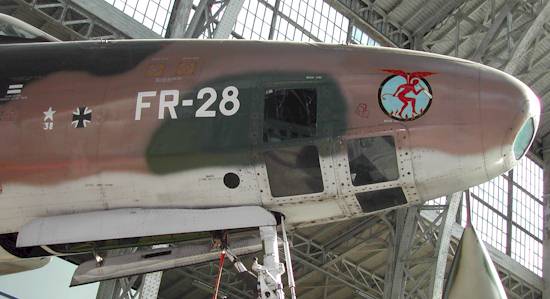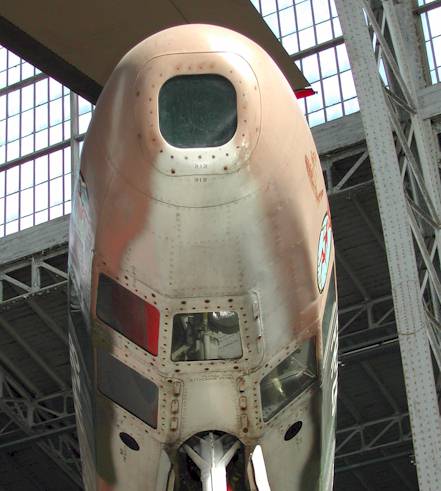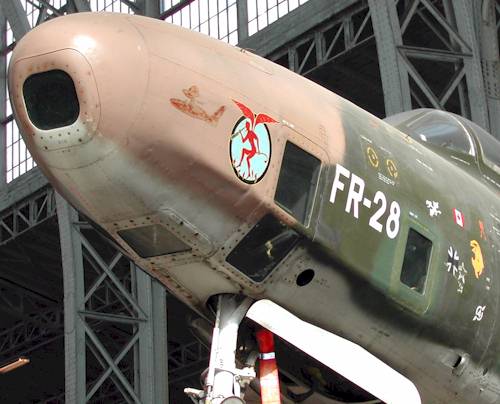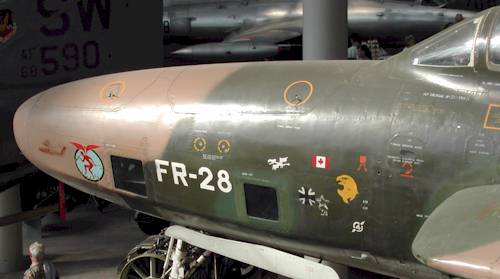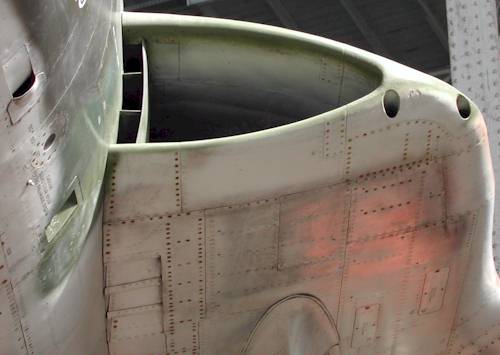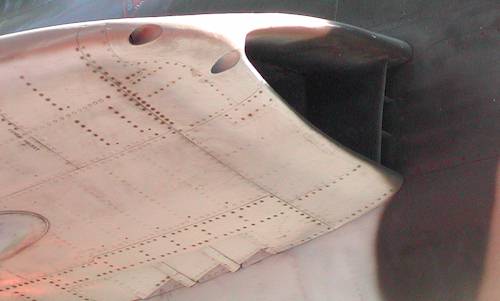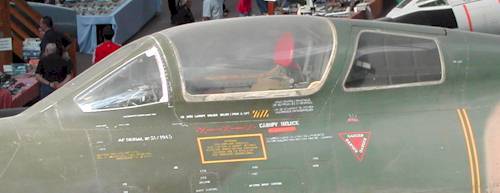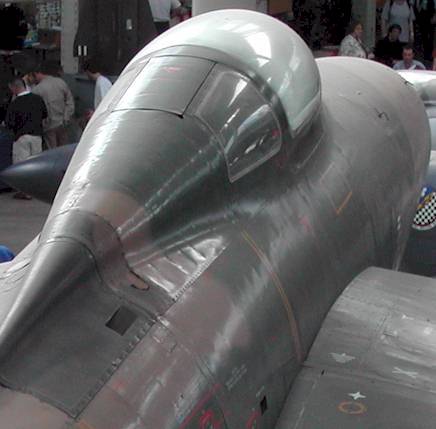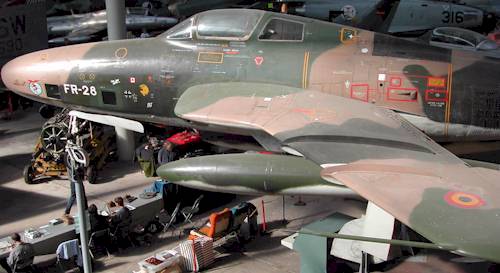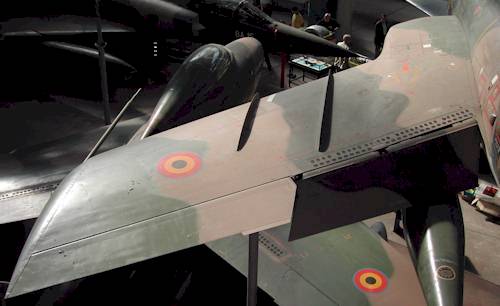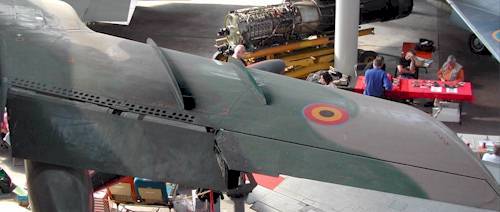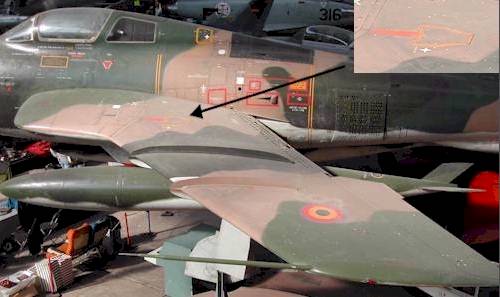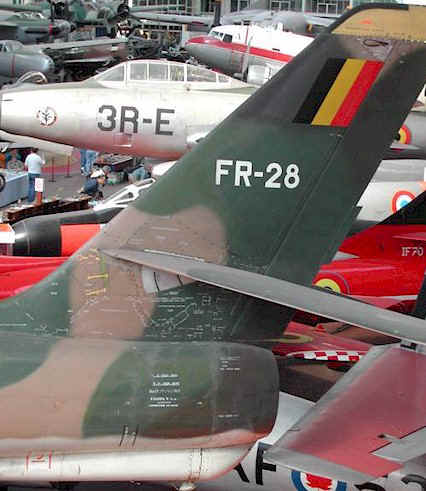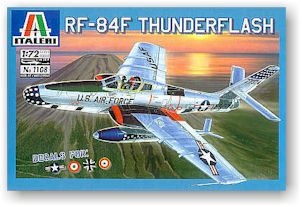Photos and text by Magnus Fridsell
The Thunderflash was the subject of an article on this site a few years ago with a detailed history and photos of a former West-German Airforce aircraft (RF-84F at Hermeskeil). With the recent re-issue of the only available kit in 1/72 from Italeri, there sure is a need for even more details!
Being a dedicated photo-reconnaissance machine, a production run of over 700 airframes is quite impressing. Most of these served with the USAF but small batches were also exported to different NATO countries. Among those using the aircraft were Norway, Denmark, France, Belgium, the Netherlands, Italy, Turkey and Greece. The two latter countries bought their aircraft second-hand from Germany, Belgium and the Netherlands. The Greek Airforce flew its last sortie in the RF-84F in March 1991, not bad for a second-generation jet first flown in 1952!
This Thunderflash
The subject of this photo feature is a Belgian Airforce aircraft, now residing in the very good museum in Brussels, Koninklijk Legermuseum. Coded FR-28 in Belgian service, it is former 51-1945 of the USAF. All photos were taken on Sunday, September 15 2002. (Battle of Britain day with Manneken Pis dressed in RAF uniform!)
Other kinds of Thunder in the Belgian Airforce
The Belgian Airforce operated all three main variants of the F-84 series; the straight wing Thunderjet, the swept wing Thunderstreak and the very similar Thunderflash which is the subject of this article. All three types are represented at the museum in Brussels.
RF-84F Thunderflash in detail
The photos have been divided into three sections linked here. In this issue I have also included a short note on the subject of painting and markings of Belgian RF-84Fs.
Nose and camera installation
The business end of a Thunderflash. Right hand side of the nose with its camera windows.
The forward facing camera port with the front vertical port behind that. The reddish shine from the forward right oblique window is not due to tinted glass but rather because of the red Hawker Hunter parked besides the Thunderflash!
Left hand side of the nose. Note that the window configuration differs from side to side. Also of interest is the prismatic shape of the nose to accomodate for flat, optically perfect, windows.
The camera arrangement was impressive in these aircraft. There was provision for a total of six cameras, depending on type of mission. Also noteworthy is the amount of unofficial ”tagging”, probably after visits to other NATO bases.
Intakes, landing gear, spoilers and air brakes
Left hand air intake. The splitter plate and its supports are noteworthy features, as are the louvered outlets on the lower surface. The two holes outboard of the intake are for two of the four .5 inch cannons. These were strictly for self-defense and the only kind of arms an RF-84 carried.
Right hand air intake. The upper surface colours wrap around both the intake lips and the leading edge of the wing extension.
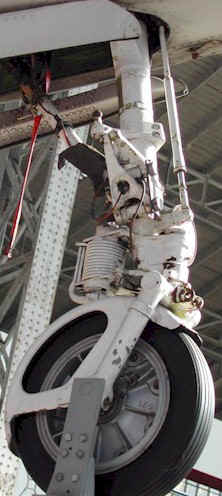 The rather complicated nose gear with
The rather complicated nose gear with
anti-shimmy devices, mud guard, torque link and,
on the opposite side, even a landing light.
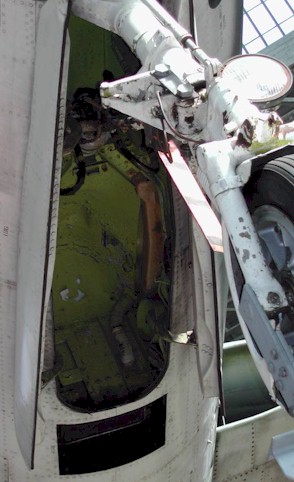 A view into the wheel well which is
A view into the wheel well which is
predominantly zinc-chromate green.
The large opening aft of this is the window for the main vertical camera.
Right hand main gear, which are of a lot simpler
design than the 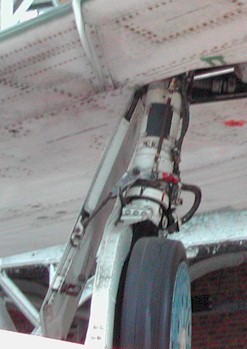 nose gear unit! The lower door is
nose gear unit! The lower door is
fixed to the gear leg while the upper one is hinged at its top edge.

A view into the right main gear well. Note the retraction cylinder, the beam dividing the well in two parts and the assorted plumbing inside!
A view of the airbrake and the spoilers. The spoilers, in the wings just forward of the flaps, operated automatically to boost roll performance.
A close-up of the spoilers and the flap in its down position..
Canopy area and main airframe
Even from the outside, the characteristic headrest tells us that the Belgian Thunderflashes flew with the same kind of old ejection seat as the Thunderjet. Drawings of the cockpits of the three main variants of the F-84 shows that they are very similar, the RF-84 differing by having a large photo sight centrally placed on the instrument panel. Thunderstreaks with high serial numbers had a different ejection seat and some of the West-German Airforce are rumoured to have been retro-fitted with Martin-Baker units.
From this angle, the bulged profile of the canopy is clearly seen. Also of interest is the black dielectric panel with a small airscoop for cooling the electronics.
An overall view of the left hand side of the aircraft. The amount of stenticlling is remarkable, especially around the mid fuselage.
Another view giving a good impression of the ”Vietnam-style” camouflage. Note that the Thunderstreak fighter parked below has an almost identical wing!
Right wing. The colours look different due to the difficult lighting conditions at the museum.
Another view of the left wing with a close-up of the in-flight refuelling receptacle. This was of hte same design as that of both the Thunderjet and the Thunderstreak.
A close-up view of the fin. A lot of stencilling here as well! Note the natural metal sector around the stabilizer hinge.
Thunderflash models and acessories
There is one big advantage when you feel the urge to build a Thunderflash; you don’t have to spend that much time when picking your model! There are two available, one each in 1/72 and 1/48 scale! In the smaller scale, there is the recently re-released Italeri kit which is basic but a sound base for a good model. The Heller kit is equally basic but the only game in town as well!
The cockpit in the Italeri kit can be upgraded using the Aires kit for the Thunderjet, with a slight adjustment of the instrument panel to accommodate for the photo sight. Apart from that, some sanding and rescribing is needed.
The Italeri kit in its latest, and very attractive, boxing.
Four decal options are included; USAF, Italian, West German and French.
Further Reading
There are few books on the subject of the Thunderflash, two that I know are the following:
- Republic F-84 Thunderjet, Thunderstreak, & Thunderflash – A Photo Chronicle by David R. McLaren, Schiffer Publishing, 1998, ISBN 0-7643-0444-5
- Republic F-84 (Swept-wing Variants) by Kevin Keaveney, Aerofax Minigraph 15, Aerofax, 1987, ISBN 0-942548-20-5
If I had to pick one of them, I would go for the Minigraph since it gives a lot of information for a relatively low price. However, the Schiffer book is quite nice as well! If you are into Belgian aircraft, there is a nice book on the Thunderstreak which will be of great help even for Thunderflash modellers:
- De Republic F-84F Thunderstreak in dienst bij de Belgische Luchtmacht by André van Haute, Uitgeverij De Krijger, 1999, ISBN 90-72547-41-1
This book contains good colour photos of all three paint schemes and also lots of other valuable information. Its only disadvantage is that it is in Flemish!
Web resources
On the World Wide Web, one of the must-visit web places for the Thunderflash enthusiast is f84thunderjet.com which, even if it is named after the first aircraft in the series, is a resource for any of the three main variants of the F-84!
Burkhard Domke has a good walkaround of a West German RF-84F at his website. Also, Robert Lundin has a walkaround of the same RF-84F as in this article at his Aircraft Walkaround website.
This article was originally published in IPMS Stockholm Magazine in October 2002.
